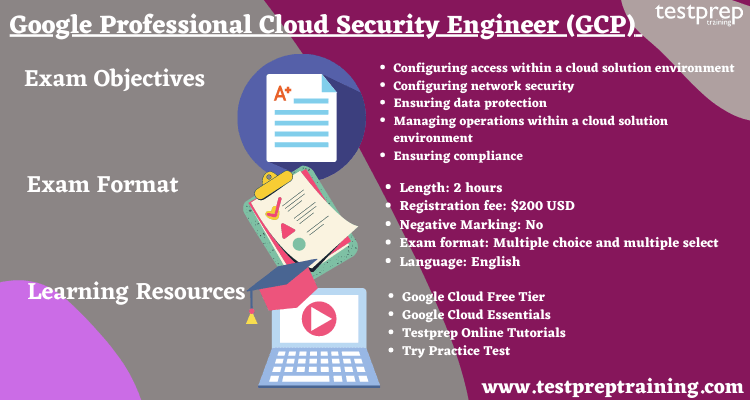Google Professional Cloud Security Engineer allows organizations to create and implement a secure foundation on the Google Cloud Platform. Also, through knowledge of security best applications and industry security specifications, this individual can design, develop, and manages a secure infrastructure leveraging Google security technologies.
Further, the Cloud Security Professional should be skilled in all perspectives of Cloud Security including maintaining the identity and access superintendence, establishing organizational structure and policies, utilizing Google technologies to present data protection, collecting and analyzing Google Cloud Platform logs, configuring network security defenses, operating incident responses, and perception of regulatory concerns.
Let us list down the reasons why the candidate should opt for this exam!
- GCP is the most significant global demand.
- Also, the high confirmation rate of Google cloud services by corporations.
- Further, the absence of cloud expertise is recognized as the #1 difficulty with cloud adoption by 25% of organizations. There’s definitely a shortage of certified Google cloud professionals available today.
- In addition, connecting Google Cloud Platform certifications with additional certifications to develop skill sets and improve salaries even more.
Exam Format
Let us now directly move to the exam format, scheduling, registering, etc.
The Google Professional Cloud Security Engineer (GCP) exam comprises multiple choice and multiple select questions that need to be answered in a time frame of 2 hours.
- Additionally, there are no mandatory prerequisites for the exam; however, Google recommends having at least 3 years of industry experience, including 1 year of experience in designing and managing solutions using GCP.
- Additionally, the Google Professional Cloud Security Engineer (GCP) Exam is available in English and Japanese language.
- Moreover, the cost of taking the exam is $200 plus taxes wherever applicable.
Registering the Exam!
To book the exam, the candidate can go to the Official Google Cloud website.
- The candidate will need a Web assessor account. They are supposed to create one in order to register themselves for the exam. To create, click here
- Create the account with their personal email address and not their work address.
- Browse the catalog and sign up for the desired exam.
- Select the exam center, like the Kryterion Testing Centre.
- Once registered for an exam, schedule a convenient exam time at a nearby Kryterion testing center. Find the nearest testing center using this link.
Furthermore, if the candidate doesn’t pass the certification exam, they can take it again after 14 days. Similarly, if you don’t pass the second time, you must wait 60 days. Further, if they don’t pass the third attempt, they will have to wait a year before trying again. Most importantly, candidates need to make a payment each time they take an exam. It’s crucial to remember that all Google Cloud certifications remain valid for two years from the certification date. Therefore, to uphold their certification status and certificate number, candidates must recertify within this timeframe.
Course Structure
Now that we have a clearer picture of the necessary details, let’s delve into the exam outline. Take a quick look at the topics that must be covered for the exam, and pay attention to:
Topic 1: Configuring access within a cloud solution environment
1.1 Configuring Cloud Identity.
- Configuring Google Cloud Directory Sync and third-party connectors
- Management of super administrator account (Google Documentation: Super administrator account best practices, Creating and managing organizations)
- Automating the user lifecycle management process
- Administering user accounts and groups programmatically
1.2 Managing service accounts. Considerations include:
- Protecting and auditing service accounts and keys (Google Documentation: Audit logs for service accounts, Understanding service accounts)
- Automating the rotation of user-managed service account keys (Google Documentation: Understanding service accounts)
- Identification of scenarios requiring service accounts (Google Documentation: Understanding service accounts, Service accounts)
- Creating, disabling, authorizing, and securing service accounts (Google Documentation: Understanding service accounts, Service accounts)
- Configuring workload identity federation
- Securing default service accounts
- Managing service account impersonation
1.3 Managing authentication.
- Creating a password policy for user accounts (Google Documentation: Enforce and monitor users’ password requirements)
- Setting up Security Assertion Markup Language (SAML) and OAuth (Google Documentation: Signing in users with SAML)
- Configuring and enforcing two-factor authentication (Google Documentation: Multi-factor authentication (MFA))
1.4 Managing and implementing authorization controls. Considerations include:
- Managing privileged roles and separation of duties with Identity and Access Management (IAM) roles and permissions
- Granting permissions to different types of identities (Google Documentation: IAM Overview)
- Managing IAM and access control list (ACL) permissions
- Designing identity roles at the organization, folder, project, and resource level
- Configuring Access Context Manager
- Applying Policy Intelligence for better permission management
- Managing permissions through groups
1.5 Defining resource hierarchy.
- Creating and managing organizations (Google Documentation: Creating and managing organizations)
- Managing organization policies for organization folders, projects, and resources
- Using resource hierarchy for access control and permissions inheritance (Google Documentation: Using resource hierarchy for access control)
Topic 2: Configuring perimeter and boundary security
2.1 Designing perimeter security. Considerations include:
- Configuring network perimeter controls (firewall rules, hierarchical firewalls, Identity-Aware Proxy [IAP], load balancers, and Certificate Authority Service)
- Identifying differences between private and public addressing
- Configuring web application firewall (Google Cloud Armor)
- Configuring Cloud DNS security settings
2.2 Configuring boundary segmentation. Considerations include:
- Configuring security properties of a VPC network, VPC peering, Shared VPC, and firewall rules
- Configuring network isolation and data encapsulation for N-tier application design
- Configuring VPC Service Controls
2.3 Establish private connectivity.
- Private RFC1918 connectivity between VPC networks and GCP projects (Shared VPC, VPC peering) (Google Documentation: VPC Network Peering overview, Using VPC Network Peering)
- Designing and configuring private connectivity between VPC networks and Google Cloud projects (Shared VPC, VPC peering, and Private Google Access for on-premises hosts)
- Designing and configuring private connectivity between data centers and VPC network (IPsec and Cloud Interconnect)
- Establishing private connectivity between VPC and Google APIs (Private Google Access, restricted Google access, Private Google Access for on-premises hosts, Private Service Connect) (Google Documentation: Configuring Private Google Access, Private access options for services)
- Using Cloud NAT to enable outbound traffic
Topic 3: Ensuring data protection
3.1 Protecting sensitive data and preventing data loss. Considerations include:
- Identifying and redaction of PII (Google Documentation: Classification, redaction, and de-identification, De-identifying sensitive data)
- Configuring pseudonymization
- Configuring format-preserving substitution
- Restricting access to BigQuery, Cloud Storage, and Cloud SQL datastores
- Securing secrets with Secret Manager
- Protecting and managing compute instance metadata
3.2 Managing encryption at rest, in transit, and in use. Considerations include:
- Understanding the use cases for Google default encryption, customer-managed encryption keys (CMEK) including customer-supplied encryption keys (CSEK), Cloud External Key Manager (EKM), and Cloud HSM (Google Documentation: Encrypt disks with customer-supplied encryption keys, Customer-Supplied Encryption Keys, Customer managed encryption keys (CMEK))
- Creating and managing encryption keys for CMEK, CSEK, and EKM
- Applying Google’s encryption approach to use cases
- Configuring object lifecycle policies for Cloud Storage
- Enabling Confidential Computing
- Encryption in transit
Topic 4: Managing operations within a cloud solution environment
4.1 Building and deploying secure infrastructure and applications. Considerations include:
- Automating security scanning for Common Vulnerabilities and Exposures (CVEs) through a continuous integration and delivery (CI/CD) pipeline
- Automating virtual machine image creation, hardening, maintenance, and patch management
- Automating container image creation, verification, hardening, maintenance, and patch management
- Automating policy as code and drift detection
4.2 Configuring logging, monitoring, and detection. Considerations include:
- Configuring and analyzing network logs (firewall rule logs, VPC flow logs, packet mirroring, Cloud Intrusion Detection System [Cloud IDS])
- Designing an effective logging strategy
- Logging, monitoring, responding to, and remediating security incidents
- Exporting logs to external security systems
- Configuring and analyzing Google Cloud audit logs and data access logs
- Configuring log exports (log sinks and aggregated sinks)
- Configuring and monitoring Security Command Center (Security Health Analytics, Event Threat Detection, Container Threat Detection, Web Security Scanner)
Topic 5: Supporting compliance requirements
5.1 Determining regulatory requirements for the cloud. Considerations include:
- Determining concerns relative to compute, data, and network
- Evaluating the security shared responsibility model (Access Transparency)
- Configuring security controls within cloud environments (regionalization of data and services)
- Limiting compute and data for regulatory compliance
- Determining the Google Cloud environment in scope for regulatory compliance
Google Professional Cloud Security Engineer (GCP) Study Guide
To start the ideal preparation for the Google Professional Cloud Security Engineer (GCP), the following details a few of the analytical steps that you should consider for developing an ideal schedule for your preparation.

- Google Cloud Free Tier– The Google Cloud Free Tier provides the candidate with free resources to study Google Cloud services. This becomes all the more enriching for a candidate if they are completely new to the platform and need to learn the basics. On the other hand, if suppose you’re an established customer and want to experiment with new solutions, the Google Cloud Free Tier has got you covered.
- Google Cloud Essentials– In this introductory-level quest, the candidate will get hands-on practice with Google Cloud’s fundamental tools and services. Google Cloud Essentials is the recommended first Quest for the Google Cloud learner. This provides the candidate with practical experience that they can apply to their first Google Cloud project.
- Additional Learning Resources – When it comes to certification exams like Google Professional Cloud Security Engineer (GCP), the more the learning resources, the better will be the outcome. So, for that, we’re providing you two Quick links for additional resources such as Google Cloud Platform Documentation and Technical Guides.
- Testprep Online Tutorials– Google Professional Cloud Security Engineer (GCP) Online Tutorial enhances your knowledge and provides a depth understanding of the exam concepts. However, these online tutorials offer in-depth information about the examination. Therefore, studying with online tutorials will enhance and strengthen your preparation.
- Try Practice Test– Practice tests play a crucial role in assuring candidates about their preparation. With numerous practice tests available online, candidates have the flexibility to choose the ones that suit them best. At Testprep training, we also provide practice tests that are highly beneficial for those preparing for the exam.



